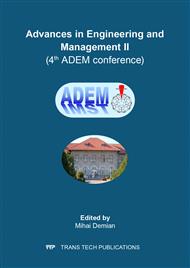[1]
K. Barik, E.L. Aksakal, K.R. Islam, S. Sari, I. Angin, Spatial variability in soil compaction properties associated with field traffic operations, Catena. 120 (2014) 122-133.
DOI: 10.1016/j.catena.2014.04.013
Google Scholar
[2]
M. Gysi, Soil compaction due to heavy agricultural wheel traffic, Swiss Federal Institute of Technology, Zurich, Switzerland, (2000).
Google Scholar
[3]
P. Schjønning, J.J.H. Van den Akker, T. Keller, M.H. Greve, M. Lamandé, A. Simojoki, M. Stettler, J. Arvidsson, H. Breuning-Madsen, Soil compaction, in: EU Joint Research Centre (Publisher), Soil Threats in Europe - Status, methods, drivers and effects on ecosystem services, 2016, pp.69-78.
DOI: 10.1016/bs.agron.2015.06.001
Google Scholar
[4]
R. Wolkowski, B. Lowery, Soil compaction: causes, concerns, and cures, A3367 (Information on http://www.soils.wisc.edu/extension/pubs/A3367.pdf).
Google Scholar
[5]
S.Şt Biriș, Mathematical modeling of soil compaction, Printech Publishing, Bucharest, (2010).
Google Scholar
[6]
J.J.H. Van den Akker, J. Arvidsson, R. Horn, Introduction to the special issue on experiences with the impact and prevention of subsoil compaction in the European Union, Soil Tillage Res. 73 (2003) 1-8.
DOI: 10.1016/s0167-1987(03)00094-1
Google Scholar
[7]
D.I. Vlăduț, Șt. Croitoru, At. Atanasov, V. Vlăduț, S.Șt. Biriș, G. Paraschiv, M.F. Duțu, I. Dumitru, N. Ungureanu, I. Găgeanu, I.D. Mircea, Aspects regarding the factors influencing soil compaction, Proceedings of the 5th International Conference Research People and Actual Tasks on Multidisciplinary Sciences. 1 (2015).
DOI: 10.3390/app11146264
Google Scholar
[8]
O.G. Cueto, C.E. Iglesias Coronel, C.A. Recarey Morfa, G. Urriolagoitia Sosa, L.H. Hernández Gómez, G. Urriolagoitia Calderón, M. Herrera Suárez, Three dimensional finite element model of soil compaction caused by agricultural tire traffic, Computers and Electronics in Agriculture. 99 (2013).
DOI: 10.1016/j.compag.2013.08.026
Google Scholar
[9]
S.Şt. Biriș, V. Vlăduț, N. Ungureanu, G. Paraschiv, Gh. Voicu, Development and experimental testinf of a FEM model for the stress distribution analysis in agricultural soil due to artificial compaction, Agriculturae Conspectus Scientificus. 74 (2009).
Google Scholar
[10]
R.L. Kushwaha, J. Shen, Finite element analysis of dynamic interaction between soil and tillage tool, Transaction of ASAE. 37/5 (1995) 1315-1319.
DOI: 10.13031/2013.27953
Google Scholar


